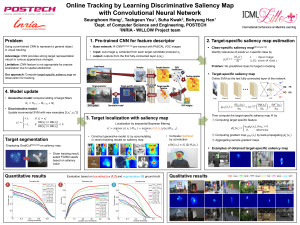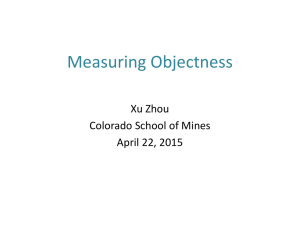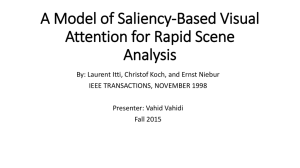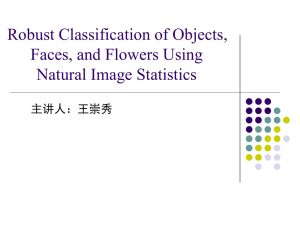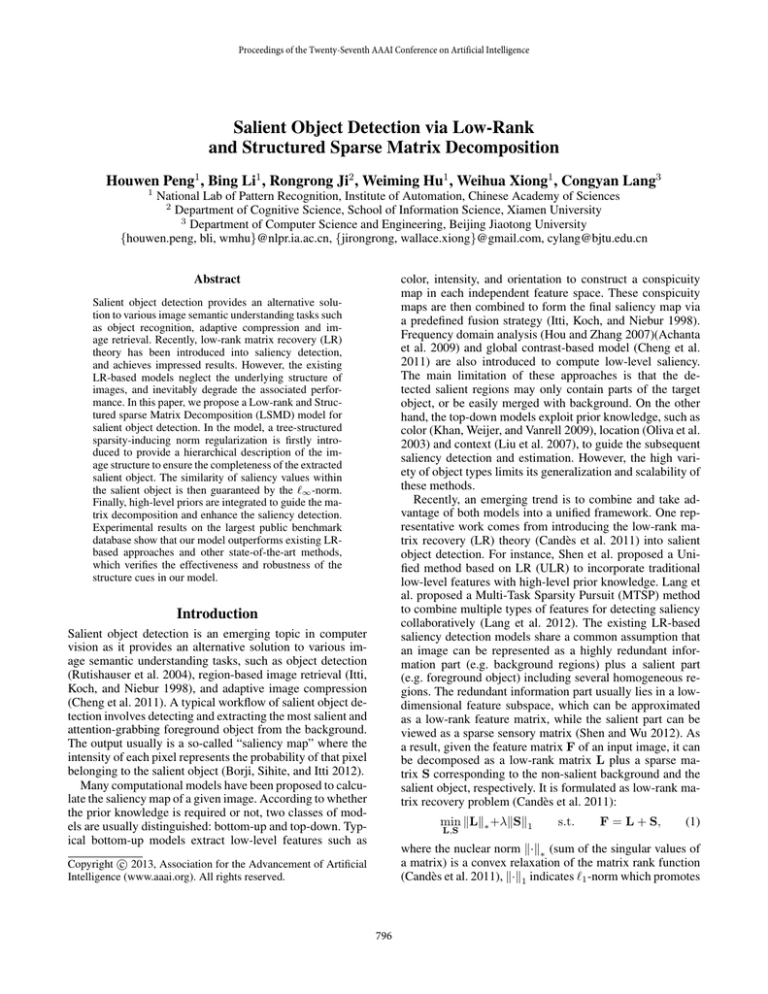
Proceedings of the Twenty-Seventh AAAI Conference on Artificial Intelligence
Salient Object Detection via Low-Rank
and Structured Sparse Matrix Decomposition
Houwen Peng1 , Bing Li1 , Rongrong Ji2 , Weiming Hu1 , Weihua Xiong1 , Congyan Lang3
1
National Lab of Pattern Recognition, Institute of Automation, Chinese Academy of Sciences
2
Department of Cognitive Science, School of Information Science, Xiamen University
3
Department of Computer Science and Engineering, Beijing Jiaotong University
{houwen.peng, bli, wmhu}@nlpr.ia.ac.cn, {jirongrong, wallace.xiong}@gmail.com, cylang@bjtu.edu.cn
Abstract
color, intensity, and orientation to construct a conspicuity
map in each independent feature space. These conspicuity
maps are then combined to form the final saliency map via
a predefined fusion strategy (Itti, Koch, and Niebur 1998).
Frequency domain analysis (Hou and Zhang 2007)(Achanta
et al. 2009) and global contrast-based model (Cheng et al.
2011) are also introduced to compute low-level saliency.
The main limitation of these approaches is that the detected salient regions may only contain parts of the target
object, or be easily merged with background. On the other
hand, the top-down models exploit prior knowledge, such as
color (Khan, Weijer, and Vanrell 2009), location (Oliva et al.
2003) and context (Liu et al. 2007), to guide the subsequent
saliency detection and estimation. However, the high variety of object types limits its generalization and scalability of
these methods.
Recently, an emerging trend is to combine and take advantage of both models into a unified framework. One representative work comes from introducing the low-rank matrix recovery (LR) theory (Candès et al. 2011) into salient
object detection. For instance, Shen et al. proposed a Unified method based on LR (ULR) to incorporate traditional
low-level features with high-level prior knowledge. Lang et
al. proposed a Multi-Task Sparsity Pursuit (MTSP) method
to combine multiple types of features for detecting saliency
collaboratively (Lang et al. 2012). The existing LR-based
saliency detection models share a common assumption that
an image can be represented as a highly redundant information part (e.g. background regions) plus a salient part
(e.g. foreground object) including several homogeneous regions. The redundant information part usually lies in a lowdimensional feature subspace, which can be approximated
as a low-rank feature matrix, while the salient part can be
viewed as a sparse sensory matrix (Shen and Wu 2012). As
a result, given the feature matrix F of an input image, it can
be decomposed as a low-rank matrix L plus a sparse matrix S corresponding to the non-salient background and the
salient object, respectively. It is formulated as low-rank matrix recovery problem (Candès et al. 2011):
Salient object detection provides an alternative solution to various image semantic understanding tasks such
as object recognition, adaptive compression and image retrieval. Recently, low-rank matrix recovery (LR)
theory has been introduced into saliency detection,
and achieves impressed results. However, the existing
LR-based models neglect the underlying structure of
images, and inevitably degrade the associated performance. In this paper, we propose a Low-rank and Structured sparse Matrix Decomposition (LSMD) model for
salient object detection. In the model, a tree-structured
sparsity-inducing norm regularization is firstly introduced to provide a hierarchical description of the image structure to ensure the completeness of the extracted
salient object. The similarity of saliency values within
the salient object is then guaranteed by the `∞ -norm.
Finally, high-level priors are integrated to guide the matrix decomposition and enhance the saliency detection.
Experimental results on the largest public benchmark
database show that our model outperforms existing LRbased approaches and other state-of-the-art methods,
which verifies the effectiveness and robustness of the
structure cues in our model.
Introduction
Salient object detection is an emerging topic in computer
vision as it provides an alternative solution to various image semantic understanding tasks, such as object detection
(Rutishauser et al. 2004), region-based image retrieval (Itti,
Koch, and Niebur 1998), and adaptive image compression
(Cheng et al. 2011). A typical workflow of salient object detection involves detecting and extracting the most salient and
attention-grabbing foreground object from the background.
The output usually is a so-called “saliency map” where the
intensity of each pixel represents the probability of that pixel
belonging to the salient object (Borji, Sihite, and Itti 2012).
Many computational models have been proposed to calculate the saliency map of a given image. According to whether
the prior knowledge is required or not, two classes of models are usually distinguished: bottom-up and top-down. Typical bottom-up models extract low-level features such as
min kLk∗ +λkSk1
L,S
s.t.
F = L + S,
(1)
where the nuclear norm k·k∗ (sum of the singular values of
a matrix) is a convex relaxation of the matrix rank function
(Candès et al. 2011), k·k1 indicates `1 -norm which promotes
c 2013, Association for the Advancement of Artificial
Copyright Intelligence (www.aaai.org). All rights reserved.
796
Figure 2: A sample index tree for illustration. Depth1
(Root): G11 = {1, 2, 3, 4, 5, 6, 7, 8}. Depth2: G21 =
{1, 2, 3, 4}, G22 = {5, 6}, G23 = {7, 8}. Depth3: G31 =
{1, 2}, G32 = {3, 4}, G33 = {5}, G34 = {6}.
Figure 1: Saliency maps of two typical challenging cases
computed by LR-based models and our proposed LSMD
model. The outputs of MTSP and ULR are scattered and incomplete, while ours uniformly cover the whole salient objects which are close to ground truth (GT).
[f1 , f2 , . . . , fN ] ∈ RD×N . Then, the task of salient object detection is to design an effective algorithm to decompose the
feature matrix F into a redundant information part L and a
structured salient part S formulated as:
sparsity, and the parameter λ > 0 is a tradeoff between the
two items.
From the perspective of statistical signal processing, when
using the `1 -norm to promote the sparsity on the matrix S in
Formula (1), it assumes that each element in S is independent (Zhao, Rocha, and Yu 2009)(Jia, Chan, and Ma 2012)
regardless of the potential relationships and structures (such
as spatially contiguity and pattern consistency) among them.
This assumption inevitably brings two limitations for salient
object detection: (i) The generated saliency map tends to be
scattered salient pixels or patches instead of spatially contiguous regions. (ii) The existing LR-based methods can not
uniformly highlight the whole salient object, which results
in incompleteness of the detected object. Some typical examples about these two limitations are shown in Figure 1.
To circumvent these problems, we propose a Lowrank and Structured sparse Matrix Decomposition (LSMD)
model that can capture the underlying structure of the salient
object. To the end, (i) a tree-structured sparsity-inducing
norm, which essentially is a group sparsity with a certain
tree structure, is introduced to constrain the matrix in terms
of multi-scale spatial connectivity and feature similarity. (ii)
The `∞ -norm is embedded into the tree-structured sparsityinducing norm to replace the plain `1 -norm so as to enforce
pixels within the same object have similar saliency values.
An effective optimization algorithm for LSMD model is also
given out by extending the Augment Lagrange Multipliers
(ALM) algorithm. Experimental results on the public benchmark database (Achanta et al. 2009)(Liu et al. 2007) show
that our method outperforms the state-of-the-art approaches
and can effectively extract the entire salient object.
min kLk∗ +λΩ(S)
L,S
s.t.
F = L + S,
(2)
where Ω(·) is a structured sparsity-inducing norm regularization to preserve relevant structure and latent relationship
of patches in S.
LSMD model
Tree structure is widely existed and explored in natural
image processing, e.g., tree-structured wavelet transforms,
tree-based image segmentation (Felzenszwalb and Huttenlocher 2004), etc. Recent advances in the sparse representation research also exploit tree structure to pursuit the structured sparsity in terms of relationships between patterns
(Jenatton et al. 2011). In this work, we consider a treestructured sparsity-inducing norm, which essentially is a hierarchical group sparsity, to represent the underlying structure of images in feature space.
First, we give out the definition of so-called index tree
(Liu and Ye 2010): For an index tree T with depth d,
let Gij be the j-th node at the i-th level and Ti =
{Gi1 , . . . , Gij , . . . , Gini } contain all the nodes corresponding to depth i, where ni is the number of nodes at the ith level of T . Specially, for the root node, n1 = 1, and
T1 = {G11 } = {1, 2, . . . N } (N as the patch number). Furthermore, the nodes in the tree satisfy the following conditions: (i) the nodes from the same depth level have nonoverlapping indices, i.e. for any 1 ≤ j, k ≤ ni , j 6= k, we
have Gij ∩Gik = ∅. (ii) Let Gi−1
j0 be the parent node of a nonS i
i−1
root node Gij , then Gij ⊆ Gi−1
j0 and j Gj = Gj0 . Figure 2
shows a sample index tree with eight indexes (N = 8).
Assume we have a meaningful index tree that store underlying structure information of a natural image, and impose it on S as a structured constraint. Thus, a general treestructured sparsity regularization can be written as:
Low-rank and Structured Sparse
Matrix Decomposition
Problem Formulation: For efficiency, we partition the image into non-overlapping patches as the basic image elements in saliency estimation. Assume an input image is partitioned into N patches {Pi }N
i=1 . For each patch Pi , we
extract the D-dimension feature and use vector fi ∈ RD
to represent it. The ensemble of feature vectors forms a
matrix representation of the entire input image as F =
Ω(S) =
ni
d X
X
wji kSGij kp,q ,
(3)
i=1 j=1
where wji ≥ 0 is the weight for the node Gij , SGij ∈
i
RD×|Gj | (| · | denotes the cardinality of a set) is the sub-
797
Algorithm 1 Solving LSMD via ALM algorithm.
Input: Feature matrix F, parameter λ, ρ and wji (default as
1) for each Gij .
1: Initialize L0 =0, S0 =0, Y 0 =0, µ0 =0.5, µmax = 106 ,
and ρ= 6.
2: While not converged do
3:
Lk+1 = arg min L(L,Sk ,Yk ,µk )
extending the Augment Lagrange Multipliers (ALM)(Lin et
al. 2009) algorithm. Correspondingly, Formula (4) is equivalently converted to the following augmented Lagrangian
function form:
L(L, S, Y, u) = kLk∗ + λ
+ hY , F − L −
L
k+1
S
4:
k+1
= arg min L(L
k+1
S
k
k
k
k
,S,Y ,µ )
k+1
5:
Y
= Y + µ (F − L
6:
µk+1 = min (ρµk ,µmax )
7:
k =k+1
8: End While
k+1
−S
)
L,S
wji kSGij k2,∞
(5)
,
Lk+1 = arg min L(L,Sk ,Yk ,µk )
L
2
k
= arg min kLk∗ + Yk , F − L − Sk + µ2 F−L −Sk F
matrix of S corresponding to the node Gij , and k · kp,q is
the mixed `p,q -norm1 . Consequently, Ω(·) is essentially a
weighted group sparsity with a certain tree structure, which
can fuse similar image patches into identical groups, and
meanwhile represent the relationships among groups.
The mixed `p,q -norm on SGij in Formula (3) actually includes two components: (i) The `p -norm on each column of
matrix SGij indicates saliency values calculation of corresponding patches. Inspired by the work of Lang et al., we
use `2 -norm (p = 2) to measure the saliency of each patch
in this paper. (ii) The `q -norm on the resulting saliency values is to express the relationships among the corresponding
patches within the same group. Since similar saliency values are expected to be induced for the patches within the
same group, the `∞ -norm (q = ∞) is used here. For the `∞ norm, it is the maximum saliency value of patches within a
group that decides if the group is set to saliency or not, and
it does encourage all the patches within the group take similar (hence close to the maximum) values (Jia, Chan, and Ma
2012).
After introducing the tree-structured sparsity regularization with the mixed `2,∞ -norm, the LSMD model can be
reformulated as
min kLk∗ +λ
wji kSGij k2,∞
i=1 j=1
2
Si + µ2 kF − L − SkF
where Y is the Lagrange multiplier, and µ > 0 is a penalty
parameter. To solve Formula (5), we search for the optimal
L, S, and Y iteratively. The pseudo code of optimization
procedure is outlined in Algorithm 1. We now discuss how
to update these variables in each iteration.
Updating L: To update Lk+1 at the (k + 1)-th iteration
in Algorithm 1, we fix L and S, and solve the following
problem accordingly:
Output: L and S.
ni
d X
X
ni
d P
P
L
= arg min τ kLk∗ +
L
1
2
2
kL − ML kF ,
(6)
where τ = µ1k and ML =F−Sk + µ1k Yk . The solution to Formula (6) can be solved as
Lk+1 =UTτ [Σ]VT , where(U,Σ,VT ) =SVD(ML ). (7)
Note that Σ is the singular value matrix of ML . The operator
Tτ [·] in Formula (7) is a Singular Value Thresholding (SVT)
operator (Chen, Wei, and Wang 2012), which is defined
by element-wise τ thresholding of Σ, i.e., diag(Tτ [Σ]) =
[tτ [σ1 ], tτ [σ2 ], . . . , tτ [σr ]] for rank(Σ) = r, where each
tτ [σ] is determined as
(
σ − τ,
if σ > τ,
σ + τ, if σ < −τ,
tτ [σ] =
(8)
0,
otherwise.
Updating S: To update Sk+1 , we derive Formula (5) with
fixed L and Y, and obtain the following form:
Sk+1 = arg min L(Lk+1 ,S,Yk ,µk )
S
ni
d P
P
= arg min λ
wji kSGij k2,∞
S
i=1 j=1
2
k + Yk , F − Lk+1 − S + µ2 F − Lk+1 − SF
ni
d P
P
2
wji kSGij k2,∞ + 12 kS−MS kF ,
= arg min ε0
s.t. F=L+S. (4)
i=1 j=1
It is noted that by setting the index tree to be a single layer
one (d = 1, wji = 1, and q = 1), Formula (4) will be degraded to Formula (1). Therefore, LSMD can be regarded
as a generalization of the standard LR model (Candès et al.
2011).
S
i=1 j=1
(9)
where ε0 = µλk and MS =F − Lk+1 + µ1k Yk . The above
tree-structured sparsity optimization problem can be solved
by a hierarchical group thresholding operator (Jenatton et al.
2011), which uses the orthogonal projection onto the `1 -ball
as a relaxation for the `∞ -norm.
Optimization via ALM
Considering both the nuclear norm and the tree-structured
sparsity-inducing norm are convex, we can optimize them by
The mixed `p,q -norm of a matrix X ∈ Rm×n is defined as :
n
P
kXkp,q = (
kxi kqp )1/q = (kx1 kp , . . . , kxn kp ) , where xi
1
i=1
LSMD-based Salient Object Detection
This section elaborates on the salient object detection using the proposed LSMD model. This detection is basically
q
is the i-th column of the matrix.
798
Figure 3: Framework of the LSMD model for salient object detection.
deployed over the low-level features as detailed in the first
part of this section, then high-level prior knowledge can be
further introduced into the proposed LSMD model, as discussed in the second part. Figure 3 shows the LSMD-based
saliency object detection framework.
Low-level Salient Object Detection
Our framework for low-level salient object detection based
on the LSMD model consists of four steps as below.
Image Abstraction. In the first step, we aim to partition an input image into compact and perceptually homogeneous elements. Following (Shen and Wu 2012), we first
extract the low-level features including RGB color, steerable pyramids (Simoncelli and Freeman 1995), and Gabor
filter (Feichtinger and Strohmer 1998) to construct a 53dimension feature space. Then, we perform the mean-shift
clustering (Comanicu and Meer 2002) in the feature space
to over-segment the image into N basic patches {Pi }N
i=1 .
Each patch is represented by fi , the ensemble of which forms
the feature matrix as F = [f1 , f2 , . . . , fN ] ∈ RD×N (here
D = 53).
Tree Construction. The second step is to construct an index tree to represent the image structure via divisive hierarchical k-means clustering. During the tree construction, for
each image patch Pi , we get its position coordinate pi and
feature representation fi . All patches from an image comN
N
posite a set of N data points W= {wi }i=1 = {[pi , fi ]}i=1 .
Then the divisive hierarchical clustering starts with all the
points in a single cluster, and then recursively divides each
cluster into k child clusters using k-means algorithm. The
recursion terminates when all the clusters contain less than
k data points. In this paper, we exploit a quad-tree structure
(k = 4). Figure 4 shows a visualized example of hierarchical
clustering, resulting in a 6-layer index tree structure.
Matrix Decomposition. After obtaining the feature matrix representation and the corresponding structured index
tree of the input image, the third step is to use the proposed
LSMD model defined in Formula (4) to decompose F into
a low-rank component L and a structured sparse component
S. By introducing the tree-structured sparsity regularization
into the LSMD model, we can group perceptually homogeneous patches of the foreground object, while discarding the
Figure 4: Illustration of index tree construction based on the
divisive hierarchical k-means clustering. From left to right,
each image indicates one layer in the index tree, and each
patch represents one node.
non-salient background.
Saliency Assignment. The last step is to transform image representation from the feature domain to the spatial domain. To the end, we define a simple assignment function
on the structured matrix S to give a saliency value for each
patch Pi :
Sal(Pi ) = ksi k2 ,
(10)
where si is the i-th column of matrix S. A larger response
of Sal(Pi ) means a higher saliency rendered on the corresponding image patch. The resulting saliency map is obtained though merging all patches together. After normalizing and high-dimensional Gaussian filtering (Adams, Baek,
and Davis 2010)(Perazzi et al. 2012) on each pixel (x, y),
we can get the final pixel-level saliency map M ap(x, y) =
Sal(Pi ) where (x, y) ∈ Pi .
Generalized to Integrate High-level Priors
We further extend the proposed LSMD-based saliency detection to integrate high-level priors. Inspired by the work of
Shen et al., we employ the Gaussian distribution to fit the location, semantic and color priors, and fuse them to generate
a high-level prior map (see Figure 3). Then the map is incorporated into the proposed LSMD model through setting the
weight parameter wji defined in Formula (4).
For each patch Pi , we can use its corresponding average prior value, i.e. πi ∈ [0, 1], to represent its high-level
information. Thus, the prior map is formulated as a vec-
799
tor Π = [π1 , π2 , . . . , πN ] and then embedded into the treestructured sparsity-inducing norm as the weight via:
wji = 1 − max(ΠGij ),
(11)
i
where ΠGij ∈ R|Gj | is the sub-vector of Π corresponding to
the node Gij . Formula (11) indicates that the node with high
prior probability value tends to be salient, and therefore has a
small penalty wji . As a result, the high-level prior knowledge
is seamlessly integrated with the proposed LSMD model to
guide the matrix decomposition to enhance the saliency detection. It is worth noting that if we fix wji = 1 for each node
Gij , the proposed model is degraded to be a pure low-level
saliency detection model.
(A)
Figure 5: Comparisons with the existing LR-based methods.
The superscript “*” in the figure indicates the method without priors.
Experiments and Comparisons
In the proposed LSMD-base saliency detection models,
the tradeoff parameter λ in Formula (4) has a notable influence on the detection performance. To avoid the dependency
between datasets for parameter selection and performance
evaluation, we use images from MSRA dataset that has no
intersection with the 1000-image test dataset to find the optimal parameter λ. We find experimentally that the best choice
is λ=0.25.
We evaluate our LSMD-based saliency computation model
on the 1000-image publicly available dataset provided by
Achanta et al., which is a subset of MSRA dataset (Liu et
al. 2007). This 1000-image dataset is the largest of its kind
(Cheng et al. 2011) with accurate manual labels as binary
ground truth. We also provide an extensive comparison of
our method to the existing LR-based methods and 10 prevailing algorithms, as detailed later. In our experiments, we
try to answer the following two key questions on saliency
detection:
Q1: Is the tree-structured sparsity regularization beneficial
for salient object detection. And how does the proposed
LSMD method compare to the existing LR-based methods?
Q2: Compared with other state-of-the-art algorithms, does
the generalized LSMD model with high-level prior knowledge have its superiority?
Comparisons with LR-based methods
To answer the question Q1, we compare our method
(LSMD) with existing LR-based methods (ULR and MTSP)
under two conditions: without priors and with priors.
In the case of pure low-level saliency detection, as shown
in Figure 5, our method outperforms other LR-based methods under the two evaluation criteria. It demonstrates that
the tree-structured sparsity regularization is much more effective than the plain `1 -norm regularization for salient object detection, because the former one improves the completeness of the extracted salient object based on multi-scale
representation of image structure.
If we consider the high-level priors, the performances of
these algorithms are all further improved as validated in Figure 5. The proposed LSMD method still achieves the best
performance due to the tree-structured regularization. It indicates that both the structured regularization and high-level
priors are beneficial for salient object detection. Interestingly, our method without priors (Ours*) even has comparable performance to MTSP with priors as shown in Figure 5(B). This phenomenon further implies that the structure cue is another important and recommendable factor for
visual saliency detection.
Evaluation Measures and Parameter Selection
Following the standard evaluation protocols in (Achanta et
al. 2009)(Cheng et al. 2011), two evaluation measures are
exploited. In the first one, we segment saliency maps using
every fixed threshold in the range [0, 255]. The segmented
binary masks are then compared with the ground truth to
compute the precision and recall at each value of the threshold, resulting in the precision versus recall curve. In the second evaluation, we use the image dependent adaptive threshold, defined as twice the mean saliency value of the entire
image (Achanta et al. 2009):
Ta =
W X
H
X
2
M ap(x, y),
W × H x=1 y=1
(12)
where W and H are the width and height of the saliency map
in pixels respectively. In this test, in addition to precision
and recall, we also compute their weighted harmonic mean
measure or F -measure, which is defined as:
Fβ =
(1 + β 2 ) × P recision × Recall
.
β 2 × P recision × Recall
(B)
Comparisons with state-of-the-art methods
In this experiment, we aim to answer the question Q2 by
comparing our method with the other 10 prevailing approaches, including classical works: bio-inspired saliency
(IT)(Itti, Koch, and Niebur 1998), fuzzy growing (MZ)(Ma
and Zhang 2003), graph-based saliency (GB)(Harel, Koch,
and Perona 2006), spatiotemporal cues (LC)(Zhai and
Shah. 2006), spectral residual saliency (SR)(Hou and Zhang
2007); and recent leading methods: salient region detection
(13)
The same as previous works (Achanta et al. 2009)(Cheng et
al. 2011), β 2 is set to be 0.3.
800
(A)
(B)
(C)
Figure 6: A and B: precision-recall curves for fixed thresholding of saliency maps. C: precision, recall, and F-measure for
adaptive thresholding. In all experiments, our method consistently outperforms all the state-of-the-art approaches.
Figure 7: Visual comparison of saliency maps. We compare our method (Ours) to existing LR-based methods and the other
10 prevailing methods. Our segmentation results (Ours-Seg), which are based on saliency maps (Ours) using simple adaptive
threshold, are close to ground truth.
algorithms. For instance, the F -measure of our method is
better than that of the best (HC) among the 10 prevailing
algorithms by more than 10%.
Figure 7 shows the visual comparison2 on several challenging images that most existing methods failed. We can
clearly see that, compared with other methods, the proposed
LSMD-based method can not only completely extract the
entire salient object from each image without many scattered patches, but also produce nearly equal saliency values
of the pixels within the salient object. This phenomenon further confirms the effect of the structural constraint.
(AC)(Achanta et al. 2008), frequency-tuned saliency (FT)
(Achanta et al. 2009), context-aware saliency (CA)(Goferman, Manor, and Tal 2010), global-contrast saliency (HC
and RC)(Cheng et al. 2011). We use authors’ implementation or the resulting saliency maps provided in (Cheng et
al. 2011)(Achanta et al. 2009) for evaluation and give out
comparison results in Figure 6. The precision versus recall curves in Figure 6(A) and (B) show that the saliency
maps generated by our LSMD method with fixed thresholding are much more accurate than those given by the other
10 prevailing algorithms, and even close to the ground truth.
Meanwhile, as shown in Figure 6(C), the performance of our
method using adaptive threshold is also superior to the other
2
Please access to our project webpage for more comparisons
and details. http://sites.google.com/site/saliencydetection
801
Conclusions
Harel, J.; Koch, C.; and Perona, P. 2006. Graph-based visual
saliency. In Proc. of NIPS, 545–552.
Hou, X., and Zhang, L. 2007. Saliency detection: A spectral
residual approach. In Proc. of CVPR, 1–8.
Itti, L.; Koch, C.; and Niebur, E. 1998. A model of saliencybased visual attention for rapid scene analysis. IEEE TPAMI
20(11):1254–1259.
Jenatton, R.; Mairal, J.; Obozinski, G.; and Bach, F. 2011.
Proximal methods for hierarchical sparse coding. Journal of
Machine Learning Research 12:2297–2334.
Jia, K.; Chan, T.; and Ma, Y. 2012. Robust and practical
face recognition via structured sparsity. In Proc. of ECCV,
331–344.
Khan, F. S.; Weijer, J. V. D.; and Vanrell, M. 2009. Topdown color attention for object recognition. In Proc. of
ICCV, 979–986.
Lang, C.; Liu, G.; Yu, J.; and Yan, S. 2012. Saliency detection by multitask sparsity pursuit. IEEE TIP 21(3):1327–
1338.
Lin, Z.; Chen, M.; Wu, L.; and Ma, Y. 2009. The augmented
lagrange multiplier method for exact recovery of corrupted
low-rank matrices. UIUC Technical Report 09(2215):1–18.
Liu, J., and Ye, J. 2010. Moreau-yosida regularization for
grouped tree structure learning. In Proc. of NIPS, 1459–
1467.
Liu, T.; Sun, J.; Zheng, N.; and Tang, X. 2007. Learning to
detect a salient object. In Proc. of CVPR, 1–8.
Ma, Y.-F., and Zhang, H.-J. 2003. Contrast-based image
attention analysis by using fuzzy growing. In Proc. of ACM
MM, 374–381.
Oliva, A.; Torralba, A.; Casthelano, M.; and Henderson, J.
2003. Top-down control of visual attention in object detection. In Proc. of ICIP, 253–256.
Perazzi, F.; Krähenbühl, P.; Pritch, Y.; and Hornung, A.
2012. Saliency filters: Contrast based filtering for salient
region detection. In Proc. of CVPR, 733–740.
Rutishauser, U.; Walther, D.; Koch, C.; and Perona, P. 2004.
Is bottom-up attention useful for object recognition? In
Proc. of CVPR, 37–44.
Shen, X., and Wu, Y. 2012. A unified approach to salient
object detection via low rank matrix recovery. In Proc. of
CVPR, 2296–2303.
Simoncelli, E. P., and Freeman, W. T. 1995. The steerable
pyramid: A flexible architecture for multi-scale derivative
computation. In Proc. of ICIP, 444–447.
Zhai, Y., and Shah., M. 2006. Visual attention detection in
video sequences using spatiotemporal cues. In Proc. of ACM
MM, 815–824.
Zhao, P.; Rocha, G.; and Yu, B. 2009. The composite absolute penalties family for grouped and hierarchical variable
selection. Annals of Statistics 37(6):3468–3497.
In this paper, we present a generic low-rank and structured sparse matrix decomposition model for visual saliency
computation. In the proposed model, a hierarchical treestructured sparsity-inducing norm is introduced to represent
the underlying structure of image patches in feature space.
The `∞ -norm is embedded into the tree-structured sparsity to enforce patches within the same object have similar saliency values. Moreover, high-level prior knowledge is
seamlessly integrated into our model to enhance saliency detection. Experiments indicate that the proposed model consistently achieves the superior performance on the public
benchmark dataset. For future work, we believe that the proposed model can be extended from matrix decomposition to
tensor decomposition, which will explicitly find most representative features for salient object detection.
Acknowledgments
This work is partly supported by the National Nature Science Foundation of China (Grant No. 60935002, 61005030,
61272352), the National 863 High-Tech R&D Program
of China (Grant No. 2012AA012504, 2012AA012503),
the Natural Science Foundation of Beijing (Grant No.
4121003), Guangdong Natural Science Foundation (Grant
No. S2012020011081) and Xiamen University 985 Project.
References
Achanta, R.; Estrada, F.; Wils, P.; and Süsstrunk, S. 2008.
Salient region detection and segmentation. In Proc. of ICVS,
66–75.
Achanta, R.; Hemami, S.; Estrada, F.; and Süsstrunk, S.
2009. Frequency-tuned salient region detection. In Proc.
of CVPR, 1597–1604.
Adams, A.; Baek, J.; and Davis, M. A. 2010. Fast highdimensional filtering using the permutohedral lattice. Comput. Graph. Forum 29(2):753–762.
Borji, A.; Sihite, D. N.; and Itti, L. 2012. Salient object
detection: A benchmark. In Proc. of ECCV, 414–429.
Candès, E.; Li, X.; Ma, Y.; and Wright, J. 2011. Robust
principal component analysis? J. ACM 58(3):1–39.
Chen, C.-F.; Wei, C.-P.; and Wang, Y.-C. 2012. Low-rank
matrix recovery with structural incoherence for robust face
recognition. In Proc. of CVPR, 2618–2625.
Cheng, M.; Zhang, G.; Mitra, N. J.; Huang, X.; and Hu, S.
2011. Global contrast based salient region detection. In
Proc. of CVPR, 409–416.
Comanicu, D., and Meer, P. 2002. Mean shift: A robust approach toward feature space analysis. IEEE PAMI
24(5):603–619.
Feichtinger, H. G., and Strohmer, T. 1998. Gabor analysis
and algorithms:theory and applications. Springer.
Felzenszwalb, P., and Huttenlocher, D. 2004. Efficient
graph-based image segmentation. International Journal of
Computer Vision 59(2):167–181.
Goferman, S.; Manor, L. Z.; and Tal, A. 2010. Contextaware saliency detection. In Proc. of CVPR, 1915–1926.
802



